Old English literature refers to poetry and prose written in Old English in early medieval England, from the 7th century to the decades after the Norman Conquest of 1066, a period often termed Anglo-Saxon England. The 7th-century work Cædmon's Hymn is often considered as the oldest surviving poem in English, as it appears in an 8th-century copy of Bede's text, the Ecclesiastical History of the English People. Poetry written in the mid 12th century represents some of the latest post-Norman examples of Old English. Adherence to the grammatical rules of Old English is largely inconsistent in 12th-century work, and by the 13th century the grammar and syntax of Old English had almost completely deteriorated, giving way to the much larger Middle English corpus of literature.

The Nibelungenlied, translated as The Song of the Nibelungs, is an epic poem written around 1200 in Middle High German. Its anonymous poet was likely from the region of Passau. The Nibelungenlied is based on an oral tradition of Germanic heroic legend that has some of its origin in historic events and individuals of the 5th and 6th centuries and that spread throughout almost all of Germanic-speaking Europe. Scandinavian parallels to the German poem are found especially in the heroic lays of the Poetic Edda and in the Völsunga saga.
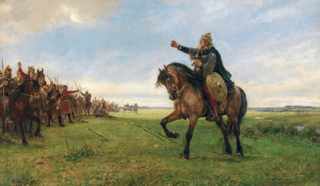
Hervarar saga ok Heiðreks is a legendary saga from the 13th century combining matter from several older sagas in Germanic heroic legend. It tells of wars between the Goths and the Huns during the 4th century. The final part of the saga, which was likely composed separately from and later than the rest, is a source for Swedish medieval history.

Gundaharius or Gundahar, better known by his legendary names Gunther or Gunnar, was a historical king of Burgundy in the early 5th century. Gundahar is attested as ruling his people shortly after they crossed the Rhine into Roman Gaul. He was involved in the campaigns of the failed Roman usurper Jovinus before the latter's defeat, after which he was settled on the left bank of the Rhine as a Roman ally. In 436, Gundahar launched an attack from his kingdom on the Roman province of Belgica Prima. He was defeated by the Roman general Flavius Aetius, who destroyed Gundahar's kingdom with the help of Hunnish mercenaries the following year, resulting in Gundahar's death.

The term Nibelung (German) or Niflungr is a personal or clan name with several competing and contradictory uses in Germanic heroic legend. It has an unclear etymology, but is often connected to the root Nebel, meaning mist. The term in its various meanings gives its name to the Middle High German heroic epic the Nibelungenlied.

The Heliand is an epic alliterative verse poem in Old Saxon, written in the first half of the 9th century. The title means "savior" in Old Saxon, and the poem is a Biblical paraphrase that recounts the life of Jesus in the alliterative verse style of a Germanic epic. Heliand is the largest known work of written Old Saxon.
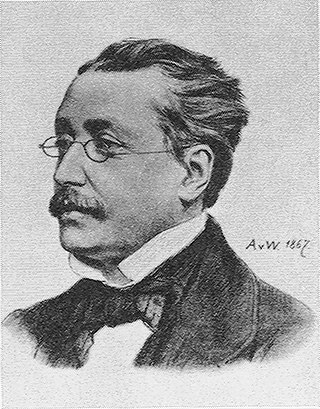
Joseph Victor von Scheffel was a German poet and novelist. His novel Ekkehard (1855) became one of the most popular German novels in the 19th century.
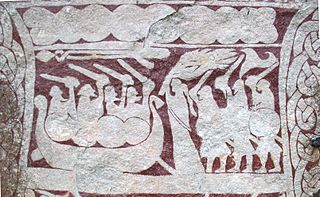
Hjaðningavíg, the legend of Heðinn and Hǫgni or the Saga of Hild is a Germanic heroic legend about a never-ending battle which is documented in Sörla þáttr, Ragnarsdrápa, Gesta Danorum, Skíðaríma and in Skáldskaparmál. It is also held to appear on the image stone at Stora Hammar on Gotland. Moreover, it is alluded to in the Old English poems Deor and Widsið, and in the Old Norse Háttalykill inn forni, and a version of it survived down to the 18th century in the traditional Norn language ballad "Hildina". An altered version of the saga is found in the Middle High German poem Kudrun, as a prologue to the story of Kudrun herself. Yet another version is found in the Old Yiddish Dukus Horant.
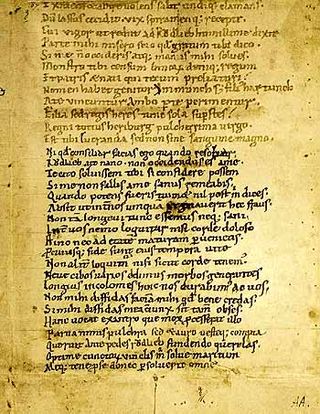
Ruodlieb is a fragmentary romance in Latin verse written by an unknown southern German poet who flourished about 1030. He was almost certainly a monk of the Bavarian Tegernsee Abbey.
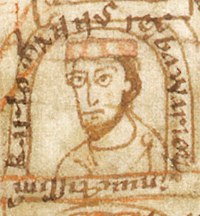
Notker Labeo, also known as Notker the German or Notker III, was a Benedictine monk active as a scholar and teacher. He was the first commentator on Aristotle active in the Middle Ages and translated the works of earlier Latin writers such as Boethius and Martianus Capella. Notker is also attributed the authorship of five short essays on music.

Walter or Walther of Aquitaine is a king of the Visigoths in Germanic heroic legend.
"Waldere" or "Waldhere" is the conventional title given to two Old English fragments, of around 32 and 31 lines, from a lost epic poem, discovered in 1860 by E. C. Werlauff, Librarian, in the Danish Royal Library at Copenhagen, where it is still preserved. The parchment pages had been reused as stiffening in the binding of an Elizabethan prayer book, which had presumably come to Europe following the Dissolution of the Monasteries in England in the 16th century.
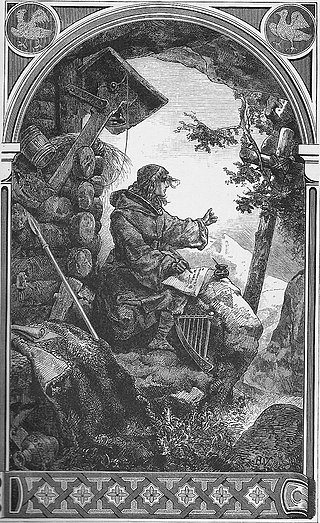
Ekkehard I, called Major or Senex, was a monk of the Abbey of Saint Gall. He was of noble birth, of the Jonschwyl family in Toggenburg, and was educated in the monastery of St. Gall; after joining the Benedictine Order, he was appointed director of the inner school there. Later, under Abbot Kralo, who trusted him implicitly, he was elected dean of the monastery, and for a while directed all the affairs of the abbey.
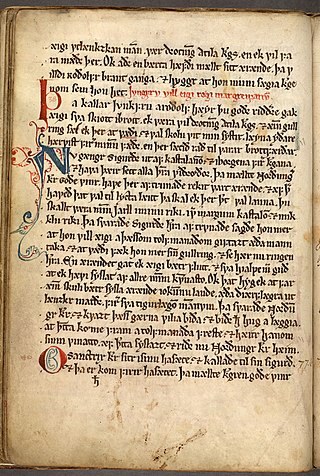
Þiðreks saga af Bern is an Old Norse saga that collects almost all Germanic heroic legends known from Germany into a single narrative. At the center of this narrative is the biography of the hero Dietrich von Bern.
Brian Oliver Murdoch is a British philologist who is Emeritus Professor of German at the University of Stirling. He specializes in the study of early Germanic and Celtic literature, on which he has authored and edited several influential works.
Ekkehard II, called Palatinus, was a monk of the Abbey of Saint Gall who became known for his sequence poetry.

Dietrich von Bern is the name of a character in Germanic heroic legend who originated as a legendary version of the Ostrogothic king Theodoric the Great. The name "Dietrich", meaning "Ruler of the People", is a form of the Germanic name "Theodoric". In the legends, Dietrich is a king ruling from Verona (Bern) who was forced into exile with the Huns under Etzel by his evil uncle Ermenrich. The differences between the known life of Theodoric and the picture of Dietrich in the surviving legends are usually attributed to a long-standing oral tradition that continued into the sixteenth century. Most notably, Theodoric was an invader rather than the rightful king of Italy and was born shortly after the death of Attila and a hundred years after the death of the historical Gothic king Ermanaric. Differences between Dietrich and Theodoric were already noted in the Early Middle Ages and led to a long-standing criticism of the oral tradition as false.

Alfred Theophil Holder was an Austrian philologist, historian, and librarian. A specialist of Latin literature and Roman history, he is best known for his editions of Horace, Caesar, Tacitus, and Avianus, as well as for his three-volume lexicon of ancient Celtic languages entitled Alt-celtischer Sprachschatz (1891–1913).

Germanic heroic legend is the heroic literary tradition of the Germanic-speaking peoples, most of which originates or is set in the Migration Period. Stories from this time period, to which others were added later, were transmitted orally, traveled widely among the Germanic speaking peoples, and were known in many variants. These legends typically reworked historical events or personages in the manner of oral poetry, forming a heroic age. Heroes in these legends often display a heroic ethos emphasizing honor, glory, and loyalty above other concerns. Like Germanic mythology, heroic legend is a genre of Germanic folklore.
















